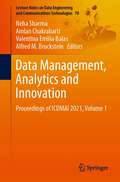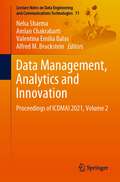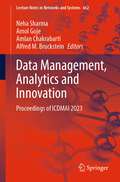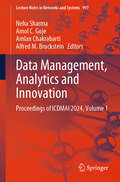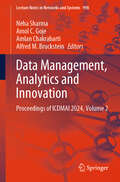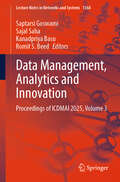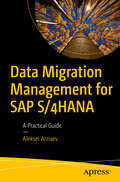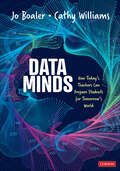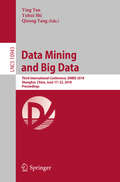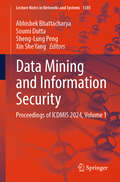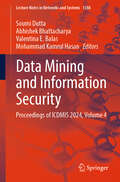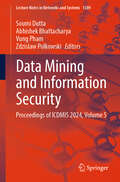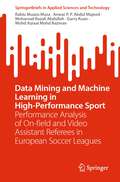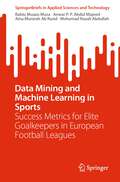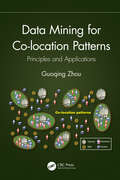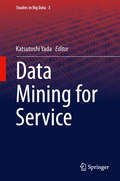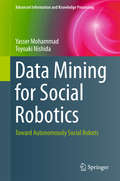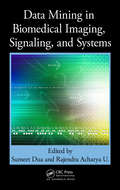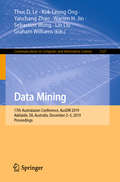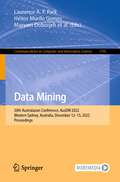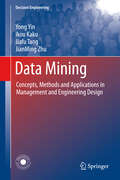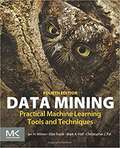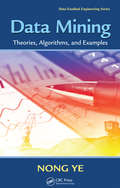- Table View
- List View
Data Management, Analytics and Innovation: Proceedings of ICDMAI 2021, Volume 1 (Lecture Notes on Data Engineering and Communications Technologies #70)
by Valentina Emilia Balas Amlan Chakrabarti Neha Sharma Alfred M. BrucksteinThis book presents the latest findings in the areas of data management and smart computing, machine learning, big data management, artificial intelligence, and data analytics, along with advances in network technologies. The book is a collection of peer-reviewed research papers presented at Fifth International Conference on Data Management, Analytics and Innovation (ICDMAI 2021), held during January 15–17, 2021, in a virtual mode. It addresses state-of-the-art topics and discusses challenges and solutions for future development. Gathering original, unpublished contributions by scientists from around the globe, the book is mainly intended for a professional audience of researchers and practitioners in academia and industry.
Data Management, Analytics and Innovation: Proceedings of ICDMAI 2021, Volume 2 (Lecture Notes on Data Engineering and Communications Technologies #71)
by Valentina Emilia Balas Amlan Chakrabarti Neha Sharma Alfred M. BrucksteinThis book presents the latest findings in the areas of data management and smart computing, machine learning, big data management, artificial intelligence, and data analytics, along with advances in network technologies. The book is a collection of peer-reviewed research papers presented at Fifth International Conference on Data Management, Analytics and Innovation (ICDMAI 2021), held during January 15–17, 2021, in a virtual mode. It addresses state-of-the-art topics and discusses challenges and solutions for future development. Gathering original, unpublished contributions by scientists from around the globe, the book is mainly intended for a professional audience of researchers and practitioners in academia and industry.
Data Management, Analytics and Innovation: Proceedings of ICDMAI 2023 (Lecture Notes in Networks and Systems #662)
by Amlan Chakrabarti Neha Sharma Alfred M. Bruckstein Amol GojeThis book presents the latest findings in the areas of data management and smart computing, big data management, artificial intelligence and data analytics, along with advances in network technologies. The volume is a collection of peer reviewed research papers presented at Seventh International Conference on Data Management, Analytics and Innovation (ICDMAI 2023), held during 20 – 22 January, 2023 in Pune, India. It addresses state-of-the-art topics and discusses challenges and solutions for future development. Gathering original, unpublished contributions by scientists from around the globe, the book is mainly intended for a professional audience of researchers and practitioners in academia and industry.
Data Management, Analytics and Innovation: Proceedings of ICDMAI 2024, Volume 1 (Lecture Notes in Networks and Systems #997)
by Amlan Chakrabarti Neha Sharma Alfred M. Bruckstein Amol C. GojeThis book presents the latest findings in the areas of data management and smart computing, big data management, artificial intelligence, and data analytics, along with advances in network technologies. The book is a collection of peer-reviewed research papers presented at 8th International Conference on Data Management, Analytics and Innovation (ICDMAI 2024), held during 19–21 January 2024 in Vellore Institute of Technology, Vellore, India. It addresses state-of-the-art topics and discusses challenges and solutions for future development. Gathering original, unpublished contributions by scientists from around the globe, the book is mainly intended for a professional audience of researchers and practitioners in academia and industry. The book is divided into two volumes.
Data Management, Analytics and Innovation: Proceedings of ICDMAI 2024, Volume 2 (Lecture Notes in Networks and Systems #998)
by Amlan Chakrabarti Neha Sharma Alfred M. Bruckstein Amol C. GojeThis book presents the latest findings in the areas of data management and smart computing, big data management, artificial intelligence, and data analytics, along with advances in network technologies. The book is a collection of peer-reviewed research papers presented at 8th International Conference on Data Management, Analytics and Innovation (ICDMAI 2024), held during 19–21 January 2024 in Vellore Institute of Technology, Vellore, India. It addresses state-of-the-art topics and discusses challenges and solutions for future development. Gathering original, unpublished contributions by scientists from around the globe, the book is mainly intended for a professional audience of researchers and practitioners in academia and industry. The book is divided into two volumes.
Data Management, Analytics and Innovation: Proceedings of ICDMAI 2025, Volume 3 (Lecture Notes in Networks and Systems #1368)
by Saptarsi Goswami Sajal Saha Kanadpriya Basu Romit S BeedThis book presents the latest findings in the areas of data management and smart computing, big data management, artificial intelligence, and data analytics, along with advances in network technologies. The book is a collection of peer-reviewed research papers presented at 9th International Conference on Data Management, Analytics and Innovation (ICDMAI 2025), held during 17–19 January 2025 at St. Xavier’s College (Autonomous), Kolkata, India. It addresses state-of-the-art topics and discusses challenges and solutions for future development. Gathering original, unpublished contributions by scientists from around the globe, the book is mainly intended for a professional audience of researchers and practitioners in academia and industry. The book is divided into three volumes.
Data Migration Management for SAP S/4HANA: A Practical Guide
by Aleksei ArziaevEnhance your data transfer and storage skills with this comprehensive step-by-step guide to managing data migration for new on-premises SAP S/4HANA implementations. This book is tailored towards small to large projects, with a focus on the managerial aspects of the data migration process rather than the technical details. You’ll follow a project-led approach, enriched with a practical case study, and a comprehensive methodology for data migration planning and documentation. Athen traverse through a detailed plan on managing and documenting data migration throughout the project lifecycle. This book utilizes the general SAP Activate methodology for on-premises solutions as its foundational framework, enhancing it with specific strategies for data migration. Structured in alignment with the project phases of the SAP Activate methodology, Data Migration Management for SAP S/4HANA methodically covers planning, organizing, and controlling the data migration process. It serves as an essential guide for professionals tasked with implementing SAP S/4HANA in their business, ensuring a thorough understanding of each data migration phase on the project. What You'll Learn Significantly decrease the time needed for both the preparation and execution of data migration activities. Foster clear transparency in data migration processes for all stakeholders, including the customer and the project team. Facilitate a seamless and timely data migration process. Establish a benchmark for data migration management in future projects. Address and remedy any deficiencies in the SAP Activate methodology pertaining to data migration. Who This Book Is For SAP projects and data migration workstreams leads, already well-versed in SAP Activate methodology and possessing moderate experience in project and workstream management, who are seeking to enhance their skills in professionally managing data migration in implementation projects.
Data Minds: How Today’s Teachers Can Prepare Students for Tomorrow’s World
by Cathy Williams Jo BoalerDevelop curious minds. Empower every learner. Shape the future. How can we prepare students for a world where data-driven decision-making shapes nearly every aspect of life? Data Minds: How Today’s Teachers Can Prepare Students for Tomorrow’s World helps K–8 educators infuse data literacy into everyday lessons across disciplines, without overwhelming existing curricula. Data literacy is an ability and willingness to engage with and understand data in the world, and it can be incorporated throughout the school day to encourage student agency. Legendary educators Jo Boaler and Cathy Williams inspire teachers to develop "data minds" in their students—fostering analytical, creative, and skeptical thinkers who can successfully navigate the data-rich world. Aligned with current math, STEM, and GAISE II standards, this book Provides innovative, real-world stories from classrooms across the globe, offering inspiration and insight from other educators Highlights five key habits of mind that position students actively, giving them a role in seeking and investigating knowledge deeply Includes engaging and fascinating examples of data visualizations that demonstrate that data analysis goes way beyond charts and strings of numbers Offers flexible frameworks, including the Four-Part Data Cycle, that focus on asking questions, analyzing patterns, and developing multi-modal representations like graphs, maps, and even art pieces Presents extensive teacher "data moves," reflection questions, and examples in each chapter showing how to connect lessons to students’ interests, from oceanography to basketball Includes online access to free professional development resources and accompanying lessons through Stanford University’s youcubed From forming data questions to cultivating creativity, Data Minds will help educators turn every lesson into an opportunity for meaningful discovery. By integrating data literacy into the curriculum, teachers can unlock new levels of student engagement at the same time they are preparing learners for the demands of tomorrow′s workforce.
Data Minds: How Today’s Teachers Can Prepare Students for Tomorrow’s World
by Cathy Williams Jo BoalerDevelop curious minds. Empower every learner. Shape the future. How can we prepare students for a world where data-driven decision-making shapes nearly every aspect of life? Data Minds: How Today’s Teachers Can Prepare Students for Tomorrow’s World helps K–8 educators infuse data literacy into everyday lessons across disciplines, without overwhelming existing curricula. Data literacy is an ability and willingness to engage with and understand data in the world, and it can be incorporated throughout the school day to encourage student agency. Legendary educators Jo Boaler and Cathy Williams inspire teachers to develop "data minds" in their students—fostering analytical, creative, and skeptical thinkers who can successfully navigate the data-rich world. Aligned with current math, STEM, and GAISE II standards, this book Provides innovative, real-world stories from classrooms across the globe, offering inspiration and insight from other educators Highlights five key habits of mind that position students actively, giving them a role in seeking and investigating knowledge deeply Includes engaging and fascinating examples of data visualizations that demonstrate that data analysis goes way beyond charts and strings of numbers Offers flexible frameworks, including the Four-Part Data Cycle, that focus on asking questions, analyzing patterns, and developing multi-modal representations like graphs, maps, and even art pieces Presents extensive teacher "data moves," reflection questions, and examples in each chapter showing how to connect lessons to students’ interests, from oceanography to basketball Includes online access to free professional development resources and accompanying lessons through Stanford University’s youcubed From forming data questions to cultivating creativity, Data Minds will help educators turn every lesson into an opportunity for meaningful discovery. By integrating data literacy into the curriculum, teachers can unlock new levels of student engagement at the same time they are preparing learners for the demands of tomorrow′s workforce.
Data Mining and Big Data: Third International Conference, DMBD 2018, Shanghai, China, June 17–22, 2018, Proceedings (Lecture Notes in Computer Science #10943)
by Ying Tan Yuhui Shi Qirong TangThis book constitutes the refereed proceedings of the Third International Conference on Data Mining and Big Data, DMBD 2018, held in Shanghai, China, in June 2018. The 74 papers presented in this volume were carefully reviewed and selected from 126 submissions. They are organized in topical sections named: database, data preprocessing, matrix factorization, data analysis, visualization, visibility analysis, clustering, prediction, classification, pattern discovery, text mining and knowledge management, recommendation system in social media, deep learning, big data, Industry 4.0, practical applications
Data Mining and Information Security: Proceedings of ICDMIS 2024, Volume 1 (Lecture Notes in Networks and Systems #1385)
by Sheng-Lung Peng Abhishek Bhattacharya Soumi Dutta Xin She YangThis book features research papers presented at the International Conference on Data Mining and Information Security (ICDMIS 2024) held at Eminent College of Management and Technology (ECMT), West Bengal, India, during October 7–8, 2024. The book is organized in five volumes and includes high-quality research work by academicians and industrial experts in the field of computing and communication, including full-length papers, research-in-progress papers, and case studies related to all the areas of data mining, machine learning, Internet of Things (IoT), and information security.
Data Mining and Information Security: Proceedings of ICDMIS 2024, Volume 4 (Lecture Notes in Networks and Systems #1388)
by Valentina E. Balas Abhishek Bhattacharya Soumi Dutta Mohammad Kamrul HasanThis book features research papers presented at the International Conference on Data Mining and Information Security (ICDMIS 2024) held at Eminent College of Management and Technology (ECMT), West Bengal, India, during October 7–8, 2024. The book is organized in five volumes and includes high-quality research work by academicians and industrial experts in the field of computing and communication, including full-length papers, research-in-progress papers and case studies related to all the areas of data mining, machine learning, Internet of Things (IoT) and information security.
Data Mining and Information Security: Proceedings of ICDMIS 2024, Volume 5 (Lecture Notes in Networks and Systems #1389)
by Abhishek Bhattacharya Soumi Dutta Zdzislaw Polkowski Vung PhamThis book features research papers presented at the International Conference on Data Mining and Information Security (ICDMIS 2024) held at Eminent College of Management and Technology (ECMT), West Bengal, India, during October 7–8, 2024. The book is organized in five volumes and includes high-quality research work by academicians and industrial experts in the field of computing and communication, including full-length papers, research-in-progress papers and case studies related to all the areas of data mining, machine learning, Internet of Things (IoT) and information security.
Data Mining and Machine Learning in High-Performance Sport: Performance Analysis of On-field and Video Assistant Referees in European Soccer Leagues (SpringerBriefs in Applied Sciences and Technology)
by Mohamad Razali Abdullah Mohd Azraai Mohd Razman Rabiu Muazu Musa Anwar P.P. Abdul Majeed Garry KuanThis book explores the application of data mining and machine learning techniques in studying the activity pattern, decision-making skills, misconducts, and actions resulting in the intervention of VAR in European soccer leagues referees. The game of soccer at the elite level is characterised by intense competitions, a high level of intensity, technical, and tactical skills coupled with a long duration of play. Referees are required to officiate the game and deliver correct and indisputable decisions throughout the duration of play. The increase in the spatial and temporal task demands of the game necessitates that the referees must respond and cope with the physiological and psychological loads inherent in the game. The referees are also required to deliver an accurate decision and uphold the rules and regulations of the game during a match. These demands and attributes make the work of referees highly complex. The increasing pace and complexity of the game resulted in the introduction of the Video Assistant Referee (VAR) to assist and improve the decision-making of on-field referees. Despite the integration of VAR into the current refereeing system, the performances of the referees are yet to be error-free. Machine learning coupled with data mining techniques has shown to be vital in providing insights from a large dataset which could be used to draw important inferences that can aid decision-making for diagnostics purposes and overall performance improvement. A total of 6232 matches from 5 consecutive seasons officiated across the English Premier League, Spanish LaLiga, Italian Serie A as well as the German Bundesliga was studied. It is envisioned that the findings in this book could be useful in recognising the activity pattern of top-class referees, that is non-trivial for the stakeholders in devising strategies to further enhance the performances of referees as well as empower talent identification experts with pertinent information for mapping out future high-performance referees.
Data Mining and Machine Learning in Sports: Success Metrics for Elite Goalkeepers in European Football Leagues (SpringerBriefs in Applied Sciences and Technology)
by Rabiu Muazu Musa Mohamad Razali Abdullah Anwar P. Majeed Aina Munirah Ab RasidThis brief highlights the factors associated with good goalkeeping techniques and their impact on goalkeepers’ performance in elite European football leagues. The goalkeeping performances of 1600 goalkeepers from five consecutive seasons across the English Premier League, Spanish La Liga, Italian Serie A, and German Bundesliga are studied. The findings from this brief are useful for identifying the success metrices of top-class goalkeepers that help stakeholders to devise strategies to further enhance their performances and empower talent identification experts with pertinent information for mapping out future high-performance goalkeepers.
Data Mining for Co-location Patterns: Principles and Applications
by Guoqing ZhouCo-location pattern mining detects sets of features frequently located in close proximity to each other. This book focuses on data mining for co-location pattern, a valid method for identifying patterns from all types of data and applying them in business intelligence and analytics. It explains the fundamentals of co-location pattern mining, co-location decision tree, and maximal instance co-location pattern mining along with an in-depth overview of data mining, machine learning, and statistics. This arrangement of chapters helps readers understand the methods of co-location pattern mining step-by-step and their applications in pavement management, image classification, geospatial buffer analysis, etc.
Data Mining for Service (Studies in Big Data #3)
by Katsutoshi YadaVirtually all nontrivial and modern service related problems and systems involve data volumes and types that clearly fall into what is presently meant as "big data", that is, are huge, heterogeneous, complex, distributed, etc. Data mining is a series of processes which include collecting and accumulating data, modeling phenomena, and discovering new information, and it is one of the most important steps to scientific analysis of the processes of services. Data mining application in services requires a thorough understanding of the characteristics of each service and knowledge of the compatibility of data mining technology within each particular service, rather than knowledge only in calculation speed and prediction accuracy. Varied examples of services provided in this book will help readers understand the relation between services and data mining technology. This book is intended to stimulate interest among researchers and practitioners in the relation between data mining technology and its application to other fields.
Data Mining for Social Robotics: Toward Autonomously Social Robots (Advanced Information and Knowledge Processing #0)
by Yasser Mohammad Toyoaki NishidaThis book explores an approach to social robotics based solely on autonomous unsupervised techniques and positions it within a structured exposition of related research in psychology, neuroscience, HRI, and data mining. The authors present an autonomous and developmental approach that allows the robot to learn interactive behavior by imitating humans using algorithms from time-series analysis and machine learning. The first part provides a comprehensive and structured introduction to time-series analysis, change point discovery, motif discovery and causality analysis focusing on possible applicability to HRI problems. Detailed explanations of all the algorithms involved are provided with open-source implementations in MATLAB enabling the reader to experiment with them. Imitation and simulation are the key technologies used to attain social behavior autonomously in the proposed approach. Part two gives the reader a wide overview of research in these areas in psychology, and ethology. Based on this background, the authors discuss approaches to endow robots with the ability to autonomously learn how to be social. Data Mining for Social Robots will be essential reading for graduate students and practitioners interested in social and developmental robotics.
Data Mining in Biomedical Imaging, Signaling, and Systems
by Rajendra Acharya U Sumeet DuaData mining can help pinpoint hidden information in medical data and accurately differentiate pathological from normal data. It can help to extract hidden features from patient groups and disease states and can aid in automated decision making. Data Mining in Biomedical Imaging, Signaling, and Systems provides an in-depth examination of the biomedi
Data Mining in Structural Dynamic Analysis: A Signal Processing Perspective
by Magd Abdel Wahab Yun Lai Zhou Nuno M. M. Maia Linya Liu Elói FigueiredoThis book highlights the applications of data mining technologies in structural dynamic analysis, including structural design, optimization, parameter identification, model updating, damage identification, in civil, mechanical, and aerospace engineering. These engineering applications require precise structural design, fabrication, inspection, and further monitoring to obtain a full life-cycle analysis, and by focusing on data processing, data mining technologies offer another aspect in structural dynamic analysis. Discussing techniques in time/frequency domain, such as Hilbert transforms, wavelet theory, and machine learning for structural dynamic analysis to help in structural monitoring and diagnosis, the book is an essential reference resource for beginners, graduates and industrial professionals in various fields.
Data Mining: 17th Australasian Conference, AusDM 2019, Adelaide, SA, Australia, December 2–5, 2019, Proceedings (Communications in Computer and Information Science #1127)
by Lin Liu Kok-Leong Ong Graham Williams Yanchang Zhao Thuc D. Le Warren H. Jin Sebastien WongThis book constitutes the refereed proceedings of the 17th Australasian Conference on Data Mining, AusDM 2019, held in Adelaide, SA, Australia, in December 2019.The 20 revised full papers presented were carefully reviewed and selected from 56 submissions. The papers are organized in sections on research track, application track, and industry showcase.
Data Mining: 20th Australasian Conference, AusDM 2022, Western Sydney, Australia, December 12–15, 2022, Proceedings (Communications in Computer and Information Science #1741)
by Yee Ling Boo Graham Williams Yun Sing Koh Yanchang Zhao Simeon Simoff Laurence A. F. Park Heitor Murilo Gomes Maryam DoborjehThis book constitutes the refereed proceedings of the 20th Australasian Conference on Data Mining, AusDM 2022, held in Western Sydney, Australia, during December 12–15, 2022. The 17 full papers included in this book were carefully reviewed and selected from 44 submissions. They were organized in topical sections as research track and application track.
Data Mining: Concepts, Methods and Applications in Management and Engineering Design (Decision Engineering)
by Jiafu Tang Yong Yin Ikou Kaku Jianming ZhuData Mining introduces in clear and simple ways how to use existing data mining methods to obtain effective solutions for a variety of management and engineering design problems. Data Mining is organised into two parts: the first provides a focused introduction to data mining and the second goes into greater depth on subjects such as customer analysis. It covers almost all managerial activities of a company, including: * supply chain design, * product development, * manufacturing system design, * product quality control, and * preservation of privacy. Incorporating recent developments of data mining that have made it possible to deal with management and engineering design problems with greater efficiency and efficacy, Data Mining presents a number of state-of-the-art topics. It will be an informative source of information for researchers, but will also be a useful reference work for industrial and managerial practitioners.
Data Mining: Practical Machine Learning Tools And Techniques
by Eibe Frank Mark A. Hall Ian H. Witten Christopher J. PalestroData Mining: Practical Machine Learning Tools and Techniques, Fourth Edition, offers a thorough grounding in machine learning concepts, along with practical advice on applying these tools and techniques in real world data mining situations. This highly anticipated fourth edition of the most acclaimed work on data mining and machine learning teaches readers everything they need to know to get going, from preparing inputs, interpreting outputs, evaluating results, to the algorithmic methods at the heart of successful data mining approaches. <P><P> Extensive updates reflect the technical changes and modernizations that have taken place in the field since the last edition, including substantial new chapters on probabilistic methods and on deep learning. Accompanying the book is a new version of the popular WEKA machine learning software from the University of Waikato. Authors Witten, Frank, Hall, and Pal include today's techniques coupled with the methods at the leading edge of contemporary research.
Data Mining: Theories, Algorithms, and Examples (Human Factors And Ergonomics Ser.)
by Nong YeNew technologies have enabled us to collect massive amounts of data in many fields. However, our pace of discovering useful information and knowledge from these data falls far behind our pace of collecting the data. Data Mining: Theories, Algorithms, and Examples introduces and explains a comprehensive set of data mining algorithms from various dat
